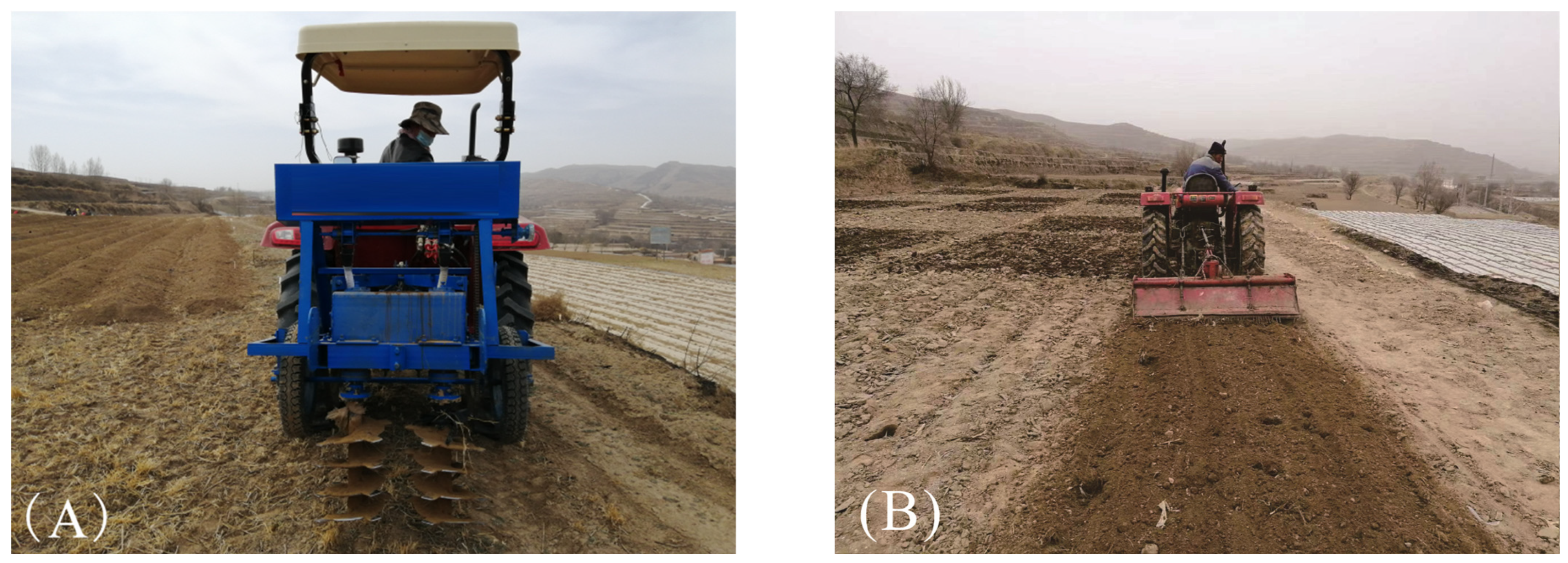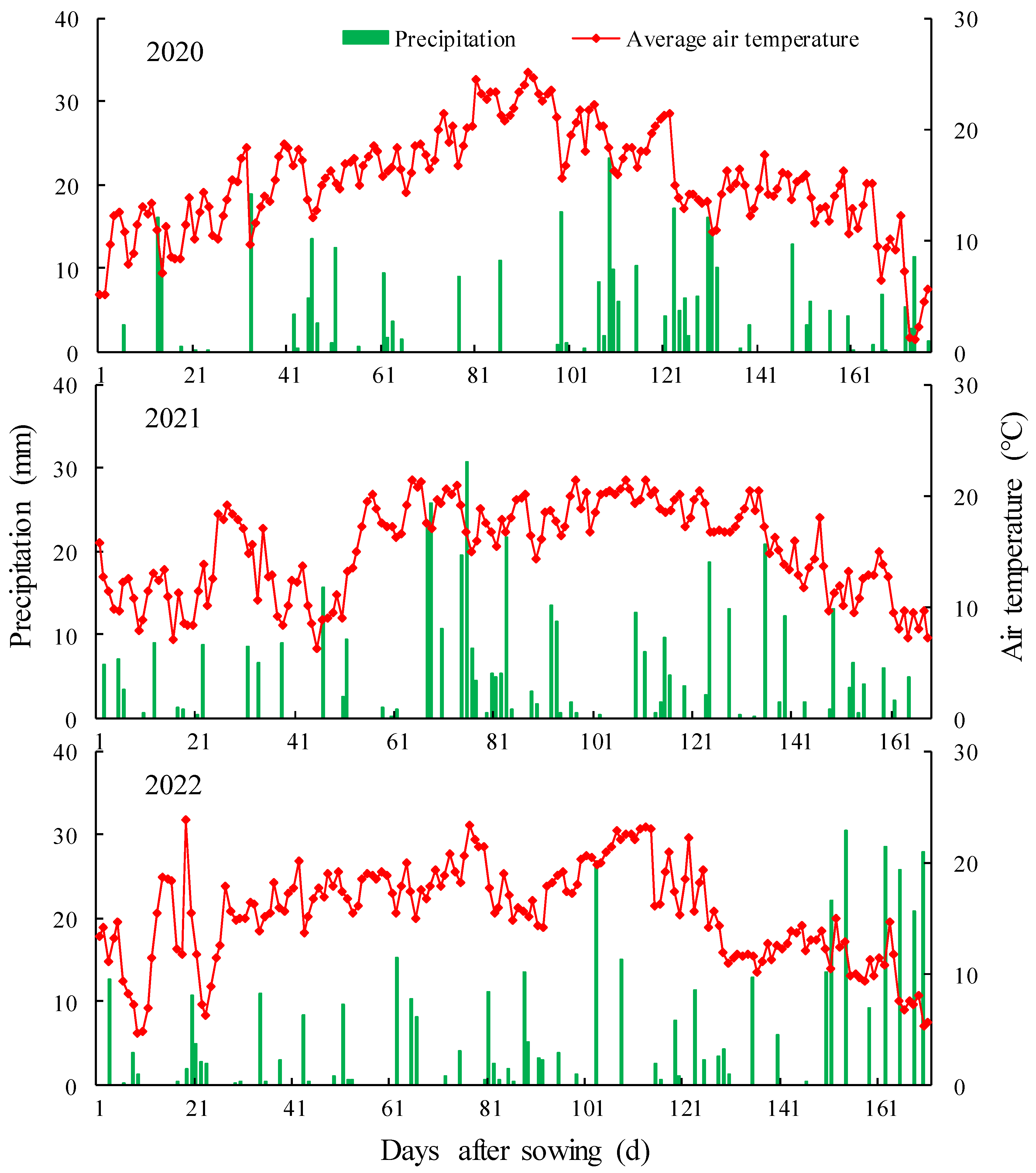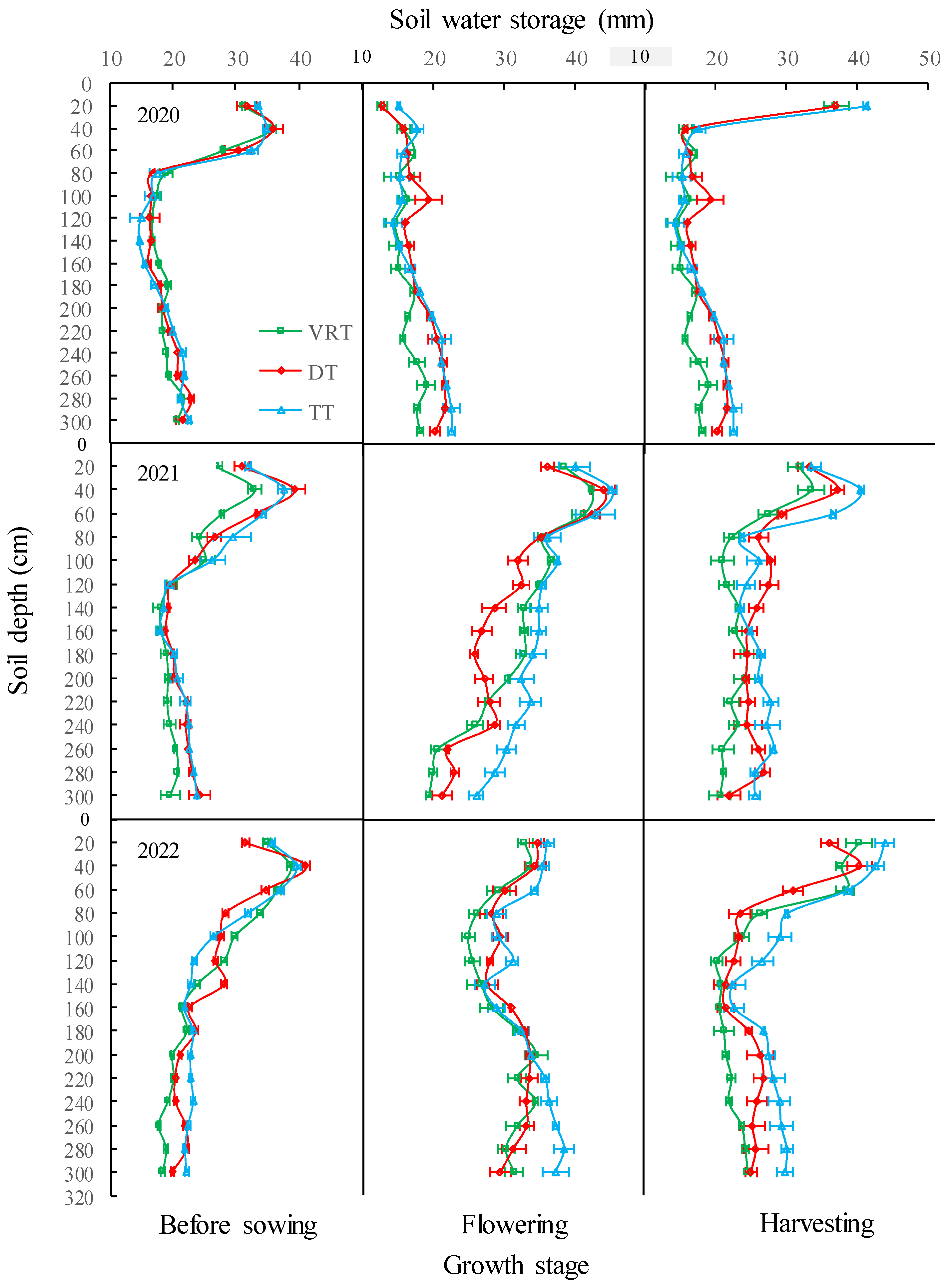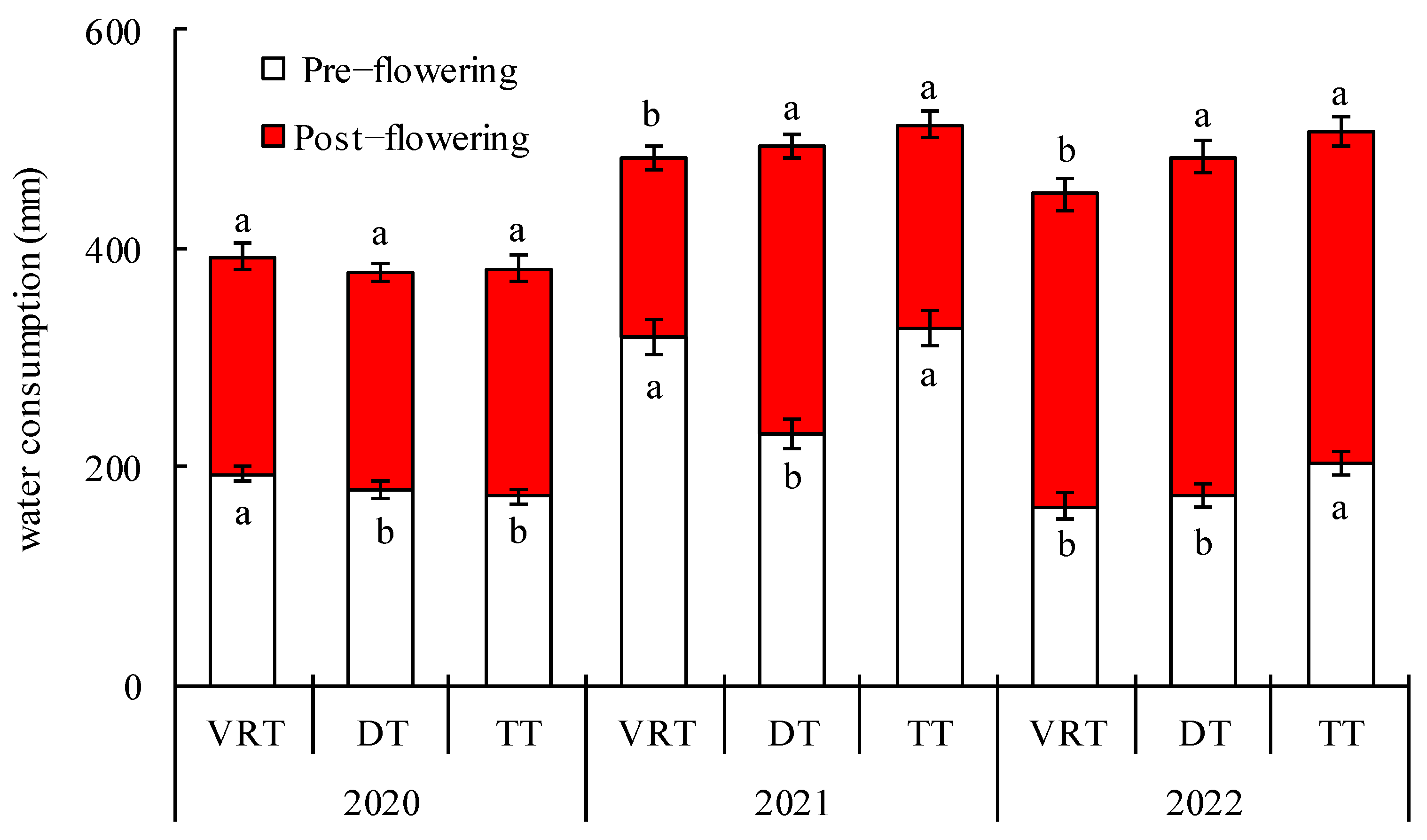Effects of Deep Vertical Rotary Tillage on Soil Water Use and Yield Formation of Forage Maize on Semiarid Land
Abstract
1. Introduction
2. Materials and Methods
2.1. Site Description
2.2. Experimental Design
2.3. Measurements
2.3.1. Precipitation and Air Temperature
2.3.2. Dry Matter Accumulation
2.3.3. Soil Water Content
2.3.4. Soil Water Storage
2.3.5. Phase Crop Evapotranspiration (ETc, mm)
2.3.6. Crop Water Consumption (ET, mm)
2.3.7. Grain Yield and Yield Components
2.3.8. Water Use Efficiency
2.4. Statistical Analysis
3. Results
3.1. Precipitation and Air Temperature during 2020 to 2022
3.2. Effect of Deep Vertical Rotary Tillage on Soil Water Storage
3.3. Effect of Deep Vertical Rotary Tillage on Crop Water Consumption
3.4. Effect of Deep Vertical Rotary Tillage on Dry Matter Accumulation
3.5. Effect of Deep Vertical Rotary Tillage on Yield Components
3.6. Effects of Deep Vertical Rotary Tillage on Grain Yield, Biomass Yield and WUE
3.7. Correlation Analysis
4. Discussion
5. Conclusions
Author Contributions
Funding
Data Availability Statement
Conflicts of Interest
References
- Wang, L.; Zechariah, E.; Fudjoe, S.K.; Li, L.; Xie, J.; Luo, Z.; Cai, L.; Khan, S.; Xu, W.; Chen, Y. Continuous maize cultivation with high nitrogen fertilizers associated with the formation of dried soil layers in the semiarid farmland on the Loess Plateau. J. Hydrol. 2022, 613, 128324. [Google Scholar] [CrossRef]
- Godfray, H.C.J.; Beddington, J.R.; Crute, I.R.; Haddad, L.; Lawrence, D.; Muir, J.F.; Pretty, J.; Robinson, S.; Thomas, S.M.; Toulmin, C. Food security: The challenge of feeding 9 billion people. Science 2010, 327, 812–818. [Google Scholar] [CrossRef] [PubMed]
- Hou, W.; Zhang, X.; Deng, H.; Zhang, X.; Wu, M.; Qin, T.; Yang, L. Comprehensive regionalization and potential water crisis for solar power development in arid and semi-arid regions of northwest China. Resour. Conserv. Recycl. 2023, 193, 106939. [Google Scholar] [CrossRef]
- Zhang, T.; Liu, J.; Zhang, H.; Lian, A.; Gao, F.; Zhang, Z.; Guo, Z. The Impact of Fertilizer Type on Dry Matter, Nitrogen Partitioning, and Yield of Spring Maize with Film-Side Sowing. Agronomy 2023, 13, 2999. [Google Scholar] [CrossRef]
- Luo, N.; Meng, Q.; Feng, P.; Qu, Z.; Yu, Y.; Liu, D.L.; Wang, P. China can be self-sufficient in maize production by 2030 with optimal crop management. Nat. Commun. 2023, 14, 2637. [Google Scholar] [CrossRef]
- Lun, R.; Liu, W.; Li, G.; Luo, Q. Does Digital Agricultural Technology Extension Service Enhance Sustainable Food Production? Evidence from Maize Farmers in China. Agriculture 2024, 14, 292. [Google Scholar] [CrossRef]
- Wang, S.; Luo, S.; Li, X.; Yue, S.; Shen, Y.; Li, S. Effect of split application of nitrogen on nitrous oxide emissions from plastic mulching maize in the semiarid Loess Plateau. Agric. Ecosyst. Environ. 2016, 220, 21–27. [Google Scholar] [CrossRef]
- Zhang, J.; Zhao, G.; Dang, Y.; Fan, T.; Wang, L.; Li, S.; Zhou, G.; Fudjoe, S.K.; Wang, L.; Palta, J.A. Enhancing Maize Yield and Resource Efficiency through Controlled-Release Nitrogen Fertilization on the Semiarid Loess Plateau. Agronomy 2023, 13, 2320. [Google Scholar] [CrossRef]
- Ma, R.; Jiang, C.; Shou, N.; Gao, W.; Yang, X. An Optimized Nitrogen Application Rate and Basal Topdressing Ratio Improves Yield, Quality, and Water- and N-use Efficiencies for Forage Maize (Zea mays L.). Agronomy 2023, 13, 181. [Google Scholar] [CrossRef]
- Zhao, J.; Li, M.; Wang, X.; Zhang, Y.; Zhang, L.; Wang, Z.; Liu, G. Prospects for the development of forage maize in Gansu Province. Chin. J. Eco-Agric. 2023, 25, 67–78. [Google Scholar]
- Li, H.; Wang, F.; Zhang, G.; Wang, S.; Liu, Y.; Zhao, J.; Li, M. Impact of drought on maize production in semiarid regions of the Loess Plateau. J. Agric. Res. Arid Areas 2020, 38, 89–98. [Google Scholar]
- Abbasi, P.; Babazadeh, H.; Yargholi, B.; Bakhoda, H. Development of forage maize yield–water functions by applying simultaneous different levels of irrigation and treated municipal wastewater. Irrig. Drain. 2023, 72, 119–137. [Google Scholar] [CrossRef]
- Hu, Q.; Li, X.; Shi, H.; Chen, N.; Zhang, Y. Various no-tillage years with previous residual plastic film mulching improved soil properties and agricultural benefits in an arid region. Appl. Soil Ecol. 2023, 192, 105088. [Google Scholar] [CrossRef]
- Huang, N.; Zhao, X.; Guo, X.; Sui, B.; Liu, J.; Wang, H.; Li, J. Tillage Methods Change Nitrogen Distribution and Enzyme Activities in Maize Rhizosphere and Non-Rhizosphere Chernozem in Jilin Province of China. Processes 2023, 11, 3253. [Google Scholar] [CrossRef]
- Chen, X.; Wang, L.; Zhao, J.; Zhang, Y.; Li, M.; Wang, X.; Liu, G. Soil degradation and drought susceptibility in northwest China: A review. Geoderma 2021, 387, 125–137. [Google Scholar]
- Li, J.; Wang, L.; Li, J.; Shang, J. Effects of rotational tillage on soil water content and crop yield of spring maize system on Weibei dryland. Trans. Chin. Soc. Agric. Eng. 2015, 31, 110–118. [Google Scholar]
- Li, Z.; Liu, H.; Yang, H.; Wang, T. Effects of Deep Vertical Rotary Tillage Management Methods on Soil Quality in Saline Cotton Fields in Southern Xinjiang. Agriculture 2023, 13, 1864. [Google Scholar] [CrossRef]
- Zhai, L.; Xu, P.; Zhang, Z.; Li, S.; Xie, R.; Zhai, L.; Wei, B. Effects of deep vertical rotary tillage on dry matter accumulation and grain yield of summer maize in the Huang-Huai-Hai Plain of China. Soil Tillage Res. 2017, 170, 167–174. [Google Scholar] [CrossRef]
- Sun, X.F.; Ding, Z.S.; Wang, X.B.; Hou, H.P.; Zhou, B.Y.; Yue, Y.; Ma, W.; Ge, J.Z.; Wang, Z.M.; Zhao, M. Subsoiling practices change root distribution and increase post-anthesis dry matter accumulation and yield in summer maize. PLoS ONE 2017, 12, e0174952. [Google Scholar] [CrossRef]
- Gansu Provincial Government. Plan for the Development of Forage Maize in Gansu Province; Gansu Provincial Government: Lanzhou, China, 2023; pp. 68–72.
- Shan, F.; Li, D.; Zhu, J.; Kang, S.; Wang, J. Effects of Vertical Smashing Rotary Tillage on Root Growth Characteristics and Yield of Broccoli. Agriculture 2022, 12, 928. [Google Scholar] [CrossRef]
- Yang, J.J.; Tan, W.J.; Han, J.R.; Li, F.M.; Zhang, F. Distribution pattern of rainwater in soil under vertical deep rotary tillage in dryland farmland. Agric. Water Manag. 2022, 273, 107891. [Google Scholar] [CrossRef]
- Zuber, S.M.; Behnke, G.D.; Nafziger, E.D.; Villamil, M.B. Multivariate assessment of soil quality indicators for crop rotation and tillage in Illinois. Soil Tillage Res. 2017, 174, 147–155. [Google Scholar] [CrossRef]
- Li, L.; Guan, J.X.; Chen, S.Y.; Zhang, X.Y. Intermittent Deep Tillage on Improving Soil Physical Properties and Crop Performance in an Intensive Cropping System. Agronomy 2022, 12, 688. [Google Scholar] [CrossRef]
- Meng, Q.F.; Li, D.W.; Zhang, J.; Zhou, L.R.; Ma, X.F.; Wang, H.Y.; Wang, G.C. Soil properties and corn (Zea mays L.) production under manure application combined with deep tillage management in solonetzic soils of Songnen Plain, Northeast China. J. Integr. Agric. 2016, 15, 879–890. [Google Scholar] [CrossRef]
- Zhai, L.C.; Xu, P.; Zhang, Z.B.; Wei, B.H.; Jia, X.L.; Zhang, L.H. Improvements in grain yield and nitrogen use efficiency of summer maize by optimizing tillage practice and nitrogen application rate. Agron. J. 2019, 111, 666–676. [Google Scholar] [CrossRef]
- Gathala, M.; Timsina, J.; Islam, S.; Rahman, M.; Hossain, I.; Ar-Rashid, H.; Ghosh, A.; Govaerts, B.; Mezzalama, M.; Sayre, K.D.; et al. Long-term consequences of tillage, residue management, and crop rotation on maize/wheat root rot and nematode populations in subtropical highlands. Appl. Soil Ecol. 2006, 32, 305–315. [Google Scholar]
- Zhang, Y.H.; Li, H.Y.; Sun, Y.G.; Zhang, Q.; Liu, P.Z.; Wang, R.; Li, J. Temporal stability analysis evaluates soil water sustainability of different cropping systems in a dryland agricultural ecosystem. Agric. Water Manag. 2022, 272, 107834. [Google Scholar] [CrossRef]
- Yin, J.D.; Zhang, X.C.; Ma, Y.F.; Yu, X.F.; Hou, H.Z.; Wang, H.L.; Fang, Y.J. Vertical rotary sub-soiling under ridge–furrow with plastic mulching system increased crops yield by efficient use of deep soil moisture and rainfall. Agric. Water Manag. 2022, 271, 107767. [Google Scholar] [CrossRef]
- Yao, R.J.; Gao, Q.C.; Liu, Y.X.; Li, H.Q.; Yang, J.S.; Bai, Y.C.; Zhu, H.; Wang, X.P.; Xie, W.P.; Zhang, X. Deep vertical rotary tillage mitigates salinization hazards and shifts microbial community structure in salt-affected anthropogenic-alluvial soil. Soil Tillage Res. 2023, 227, 105627. [Google Scholar] [CrossRef]
- Qin, A.; Fang, Y.; Ning, D.; Liu, Z.; Zhao, B.; Xiao, J.; Duan, A.; Yong, B. Incorporation of Manure into Ridge and Furrow Planting System Boosts Yields of Maize by Optimizing Soil Moisture and Improving Photosynthesis. Agronomy 2019, 9, 865. [Google Scholar] [CrossRef]
- Wang, F.; Xiao, J.; Ming, B.; Xie, R.; Wang, K.; Hou, P.; Liu, G.; Zhang, G.; Chen, J.; Liu, W.; et al. Grain yields and evapotranspiration dynamics of drip-irrigated maize under high plant density across arid to semi-humid climates. Agric. Water Manag. 2021, 247, 106726. [Google Scholar] [CrossRef]
- Wang, H.; Zhang, X.; Yu, X.; Hou, H.; Fang, Y.; Ma, Y. Maize-faba bean rotation under double ridge and furrows with plastic mulching alleviates soil water depletion. Agric. Water Manag. 2018, 207, 59–66. [Google Scholar] [CrossRef]
- Zhao, H.; Wang, R.; Ma, B.; Xiong, Y.; Qiang, S.; Wang, C.; Liu, C.; Li, F. Ridge-furrow with full plastic film mulching improves water use efficiency and tuber yields of potato in a semiarid rainfed ecosystem. Field Crops Res. 2014, 161, 137–148. [Google Scholar] [CrossRef]
- Matin, M.A.; Hossain, M.I.; Gathala, M.K.; Timsina, J.; Krupnik, T.J. Optimal design and setting of rotary strip-tiller blades to intensify dry season cropping in Asian wet clay soil conditions. Soil Tillage Res. 2021, 207, 104854. [Google Scholar] [CrossRef]
- Liu, Y.; Li, S.; Liu, Y.; Shen, H.; Huang, T.; Ma, X. Optimization of a nitrogen fertilizer application scheme for spring maize in full-film double-ridge furrow in Longzhong. Agric. Water Manag. 2023, 290, 108580. [Google Scholar] [CrossRef]
- Li, W.; Gu, X.; Du, Y.; Zheng, X.; Lu, S.; Cheng, Z.; Cai, W.; Chang, T. Optimizing nitrogen, phosphorus, and potassium fertilization regimes to improve maize productivity under double ridge-furrow planting with full film filming. Agric. Water Manag. 2023, 287, 108439. [Google Scholar] [CrossRef]
- Huang, C.; Huang, H.; Huang, S.; Li, W.; Zhang, K.; Chen, Y.; Yang, L.; Luo, L.; Deng, L. Effects of Straw Returning on Soil Aggregates and Its Organic Carbon and Nitrogen Retention under Different Mechanized Tillage Modes in Typical Hilly Regions of Southwest China. Agronomy 2024, 14, 928. [Google Scholar] [CrossRef]
- Lamptey, S.; Li, L.; Xie, J.; Coulter, J.A. Tillage System Affects Soil Water and Photosynthesis of Plastic-Mulched Maize on the Semiarid Loess Plateau of China. Soil Tillage Res. 2020, 196, 104479. [Google Scholar] [CrossRef]
- Xiao, J.; Zhu, S.; Han, S.; Wei, B.; He, Z.; Li, Z.; Li, R.; Wang, L.; Chen, L.; Li, S. Fenlong-Ridging Deep Tillage Integrated with Biochar and Fertilization to Improve Sugarcane Growth and Yield. Agronomy 2023, 13, 2395. [Google Scholar] [CrossRef]
- Zhou, L.; Li, F.; Jin, S.; Song, Y. How two ridges and the furrow mulched with plastic film affects soil water temperature and yield of maize on the semiarid Loess Plateau of China. Field Crops Res. 2009, 113, 41–47. [Google Scholar] [CrossRef]
- Liu, W.; Zhou, H.; Zhang, S.; Wang, Q.; Chen, Z.; Liu, Y. Effects of tillage methods on soil properties and maize yield in the Loess Plateau. Soil Tillage Res. 2019, 198, 105–115. [Google Scholar]
- Wang, J.; Pan, Z.; Pan, F.; He, D.; Pan, Y.; Han, G.; Huang, N.; Zhang, Z.; Yin, W.; Zhang, J.; et al. The regional water-conserving and yield-increasing characteristics and suitability of soil tillage practices in Northern China. Agric. Water Manag. 2020, 228, 105883. [Google Scholar] [CrossRef]
- Ren, B.; Li, X.; Dong, S.; Liu, P.; Zhao, B.; Zhang, J. Soil physical properties and maize root growth under different tillage systems in the North China Plain. Crop J. 2018, 6, 669–676. [Google Scholar] [CrossRef]
- Wu, F.; Zhai, L.; Xu, P.; Zhang, Z.; Baillo, E.H.; Tolosa, L.N.; Kimotho, R.N.; Jia, X.; Guo, H. Effects of deep vertical rotary tillage on the grain yield and resource use efficiency of winter wheat in the Huang-Huai-Hai Plain of China. J. Integr. Agric. 2021, 20, 593–605. [Google Scholar] [CrossRef]
- Zhang, X.C.; Guo, J.; Ma, Y.F.; Yu, X.F.; Hou, H.Z.; Wang, H.L.; Fang, Y.J.; Tang, Y.F. Effects of vertical rotary subsoiling with plastic mulching on soil water availability and potato yield on a semiarid Loess Plateau, China. Soil Tillage Res. 2020, 199, 104591. [Google Scholar] [CrossRef]
- Li, Z.; Liu, H.; Wang, T.; Gong, P.; Li, P.; Li, L.; Bai, Z. Deep vertical rotary tillage depths improved soil conditions and cotton yield for saline farmland in South Xinjiang. Eur. J. Agron. 2024, 156, 127166. [Google Scholar] [CrossRef]
- Wang, Q.; Chen, Z.; Liu, Y.; Zhang, L.; Li, J. Enhancing Crop Growth, Development, and Yield Formation through Appropriate Tillage Practices. Agronomy 2022, 12, 345. [Google Scholar]
- Liu, W.; Zhou, H.; Zhang, S.; Wang, F.; Chen, X. Improving Conditions for Crop Root Growth through Deep Rotary Tillage. Soil Sci. 2019, 45, 123–135. [Google Scholar]
- Zhang, L.; Wang, H.; Li, J.; Zhao, J.; Wang, X. Impact of Vertical Deep Rotary Tillage on Dry Matter Accumulation of Forage Maize. J. Crop Sci. 2021, 28, 67–78. [Google Scholar]
- Chen, X.; Wang, L.; Zhao, J.; Zhang, Q.; Min, F. Enhancing Biomass and Yield Formation through Deep Rotary Tillage Combined with Plastic Mulching. J. Agric. Res. 2018, 15, 234–245. [Google Scholar]
- Wang, H.; Li, M.; Zhang, G.; Zhao, J.; Chen, Z. Effects of Vertical Deep Rotary Tillage on Plant Growth Parameters of Forage Maize. J. Plant Growth Regul. 2020, 7, 89–98. [Google Scholar]
- Li, J.; Wang, F.; Zhang, G.; Liu, Y.; Chen, X. Promoting Crop Yield Formation with Vertical Deep Rotary Tillage. Field Crops Res. 2023, 54, 321–334. [Google Scholar]
- Wang, Q.; Chen, X.; Liu, Y.; Li, J.; Zhang, L. Effects of Vertical Deep Rotary Tillage on Soil Environment Optimization and Crop Growth: A Case Study of Forage Maize. Agronomy 2023, 13, 456. [Google Scholar] [CrossRef]
- Liu, W.; Zhou, H.; Zhang, S.; Wang, H. Impact of Tillage Practices on Soil Moisture Uptake and Seasonal Evapotranspiration in Forage Maize Cultivation. Soil Sci. 2022, 46, 234–245. [Google Scholar]
- Chen, X.; Wang, L.; Zhao, J.; Wang, Q. Influence of Climatic Factors and Tillage Practices on Biomass Yield and Water Use Efficiency of Forage Maize. J. Crop Sci. 2021, 30, 78–89. [Google Scholar]
- Li, J.; Wang, F.; Zhang, G.; Wang, Q. Effects of Precipitation Variability on Crop Water Consumption at Different Growth Stages of Forage Maize. Field Crops Res. 2023, 55, 321–334. [Google Scholar]
- Zhang, L.; Wang, H.; Li, J.; Chen, X. Impacts of Vertical Deep Rotary Tillage on Pre-flowering and Post-flowering Crop Evapotranspiration: Insights from a Field Experiment. J. Plant Growth Regul. 2022, 8, 90–102. [Google Scholar]






| Year | Treatments | Seedling | Jointing | Flowering | Filling | Harvest |
|---|---|---|---|---|---|---|
| 2020 | VRT | 16.9 ± 1.3 a | 83.0 ± 5.1 a | 182.8 ± 10.5 a | 291.7 ± 27.5 a | 424.6 ± 31.6 a |
| DT | 16.2 ± 1.1 a | 77.5 ± 4.9 b | 166.6 ± 9.5 b | 264.7 ± 22.4 b | 401.9 ± 27.5 b | |
| TT | 16.2 ± 0.8 a | 77.2 ± 4.5 b | 158.9 ± 8.9 b | 254.2 ± 20.8 b | 393.8 ± 24.3 b | |
| 2021 | VRT | 30.1 ± 1.9 a | 88.6 ± 3.2 a | 193.4 ± 12.6 a | 464.1 ± 42.5 a | 567.2 ± 57.5 a |
| DT | 29.7 ± 1.6 a | 85.5 ± 3.4 a | 166.9 ± 10.3 b | 419.7 ± 40.6 b | 512.7 ± 46.1 b | |
| TT | 29.7 ± 1.7 a | 85.4 ± 3.1 a | 164.0 ± 10.2 b | 414.4 ± 35.0 b | 502.9 ± 40.9 b | |
| 2022 | VRT | 28.3 ± 1.1 a | 92.1 ± 4.6 a | 184.2 ± 8.9 a | 410.8 ± 38.6 a | 562.5 ± 36.9 a |
| DT | 26.6 ± 0.8 b | 90.2 ± 4.5 a | 173.1 ± 8.6 b | 374.4 ± 32.4 b | 528.4 ± 34.2 b | |
| TT | 25.4 ± 0.8 b | 89.4 ± 4.4 a | 170.0 ± 8.2 b | 365.5 ± 30.7 b | 522.0 ± 32.9 b |
| Year | Treatments | Stem Diameter (cm) | Ear Length (cm) | Ear Diameter (mm) | Bald Length (cm) | Kernel Number per Ear (kernel) | 100-Kernel Weight (g) | Double Ear Rate (%) |
|---|---|---|---|---|---|---|---|---|
| 2020 | VRT | 3.3 ± 0.2 a | 14.9 ± 1.6 a | 31.5 ± 3.6 a | 6.4 ± 0.8 b | 163.5 ± 14.2 a | 22.7 ± 2.3 a | 0.0 ± 0.0 a |
| DT | 3.2 ± 0.2 a | 14.0 ± 1.4 b | 31.3 ± 3.5 a | 7.4 ± 0.9 a | 144.5 ± 13.9 b | 22.4 ± 2.0 a | 0.0 ± 0.0 a | |
| TT | 3.1 ± 0.2 b | 13.9 ± 1.2 b | 31.1 ± 3.5 a | 7.2 ± 0.9 a | 134.5 ± 11.8 b | 22.2 ± 2.0 a | 0.0 ± 0.0 a | |
| 2021 | VRT | 3.3 ± 0.2 a | 24.0 ± 2.0 a | 53.0 ± 6.8 a | 1.6 ± 0.1 c | 541.2 ± 45.6 a | 42.5 ± 3.8 a | 34.7 ± 3.6 a |
| DT | 3.2 ± 0.2 a | 22.9 ± 1.9 b | 51.7 ± 6.5 a | 2.1 ± 0.2 b | 500.8 ± 42.3 b | 41.2 ± 3.7 a | 24.3 ± 1.9 b | |
| TT | 3.2 ± 0.2 a | 22.8 ± 1.9 b | 51.4 ± 6.4 a | 2.6 ± 0.2 a | 492.9 ± 41.0 b | 40.7 ± 3.5 a | 22.9 ± 1.7 c | |
| 2022 | VRT | 3.5 ± 0.4 a | 24.3 ± 2.1 a | 55.0 ± 6.9 a | 3.8 ± 0.3 b | 573.4 ± 66.3 a | 41.9 ± 3.4 a | 63.8 ± 5.5 a |
| DT | 3.4 ± 0.3 a | 23.9 ± 2.0 a | 54.5 ± 6.6 a | 4.7 ± 0.4 a | 550.4 ± 60.2 a | 41.5 ± 3.1 a | 49.9 ± 4.3 b | |
| TT | 3.2 ± 0.2 b | 23.4 ± 2.0 a | 54.2 ± 6.6 a | 4.8 ± 0.5 a | 549.0 ± 57.6 a | 41.2 ± 3.1 a | 48.2 ± 4.2 b |
| Correlation Coefficient (R) | SWS | ETc | DM | SD | EL | ED | BL | KN | KW | DER |
|---|---|---|---|---|---|---|---|---|---|---|
| Grain yield | 0.73 * | 0.87 ** | 0.99 ** | 0.57 | 0.99 ** | 0.98 ** | −0.86 ** | 0.99 ** | 0.98 ** | 0.89 ** |
| Biomass yield | 0.61 | 0.72 * | 0.98 ** | 0.68 * | 0.92 ** | 0.89 ** | −0.82 ** | 0.91 ** | 0.90 ** | 0.85 ** |
| WUE based on grain yield | 0.64 * | 0.74 * | 0.98 ** | 0.71 * | 0.94 ** | 0.93 ** | −0.80 ** | 0.94 ** | 0.92 ** | 0.91 ** |
| WUE based on biomass yield | −0.05 | −0.09 | 0.48 | 0.81 ** | 0.29 | 0.24 | −0.24 | 0.28 | 0.23 | 0.46 |
Disclaimer/Publisher’s Note: The statements, opinions and data contained in all publications are solely those of the individual author(s) and contributor(s) and not of MDPI and/or the editor(s). MDPI and/or the editor(s) disclaim responsibility for any injury to people or property resulting from any ideas, methods, instructions or products referred to in the content. |
© 2024 by the authors. Licensee MDPI, Basel, Switzerland. This article is an open access article distributed under the terms and conditions of the Creative Commons Attribution (CC BY) license (https://creativecommons.org/licenses/by/4.0/).
Share and Cite
Fang, Y.; Tan, W.; Hou, H.; Wang, H.; Yin, J.; Zhang, G.; Lei, K.; Dong, B.; Qin, A. Effects of Deep Vertical Rotary Tillage on Soil Water Use and Yield Formation of Forage Maize on Semiarid Land. Agriculture 2024, 14, 955. https://doi.org/10.3390/agriculture14060955
Fang Y, Tan W, Hou H, Wang H, Yin J, Zhang G, Lei K, Dong B, Qin A. Effects of Deep Vertical Rotary Tillage on Soil Water Use and Yield Formation of Forage Maize on Semiarid Land. Agriculture. 2024; 14(6):955. https://doi.org/10.3390/agriculture14060955
Chicago/Turabian StyleFang, Yanjie, Weijun Tan, Huizhi Hou, Hongli Wang, Jiade Yin, Guoping Zhang, Kangning Lei, Bo Dong, and Anzhen Qin. 2024. "Effects of Deep Vertical Rotary Tillage on Soil Water Use and Yield Formation of Forage Maize on Semiarid Land" Agriculture 14, no. 6: 955. https://doi.org/10.3390/agriculture14060955
APA StyleFang, Y., Tan, W., Hou, H., Wang, H., Yin, J., Zhang, G., Lei, K., Dong, B., & Qin, A. (2024). Effects of Deep Vertical Rotary Tillage on Soil Water Use and Yield Formation of Forage Maize on Semiarid Land. Agriculture, 14(6), 955. https://doi.org/10.3390/agriculture14060955







